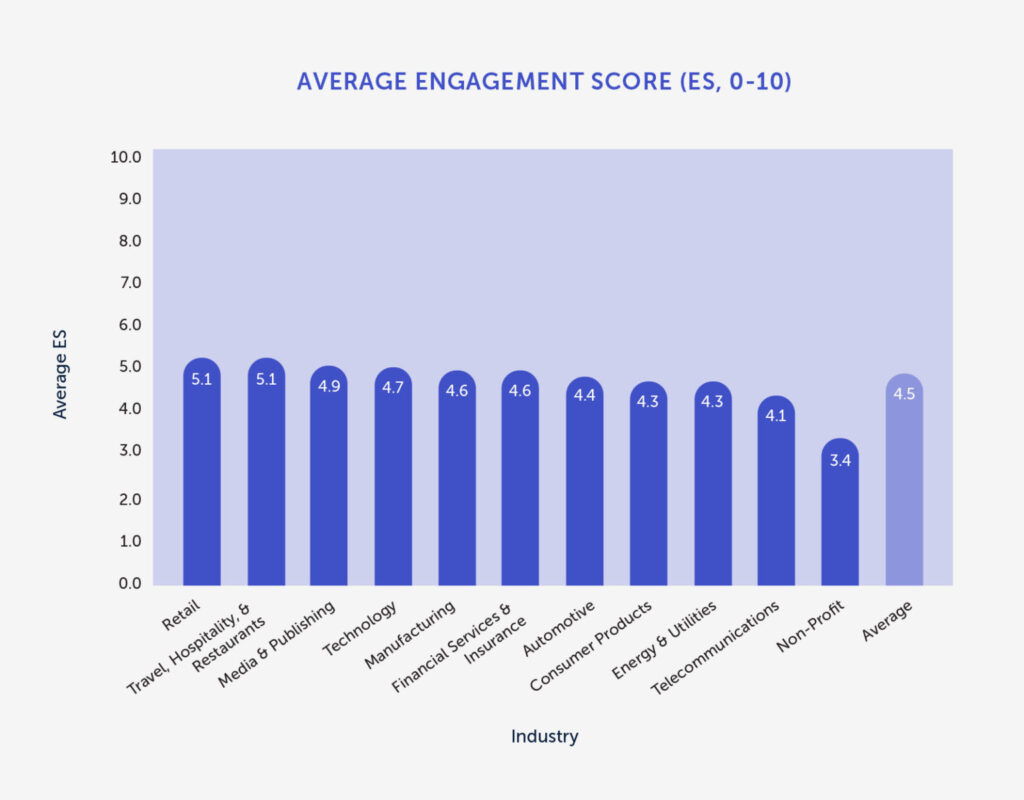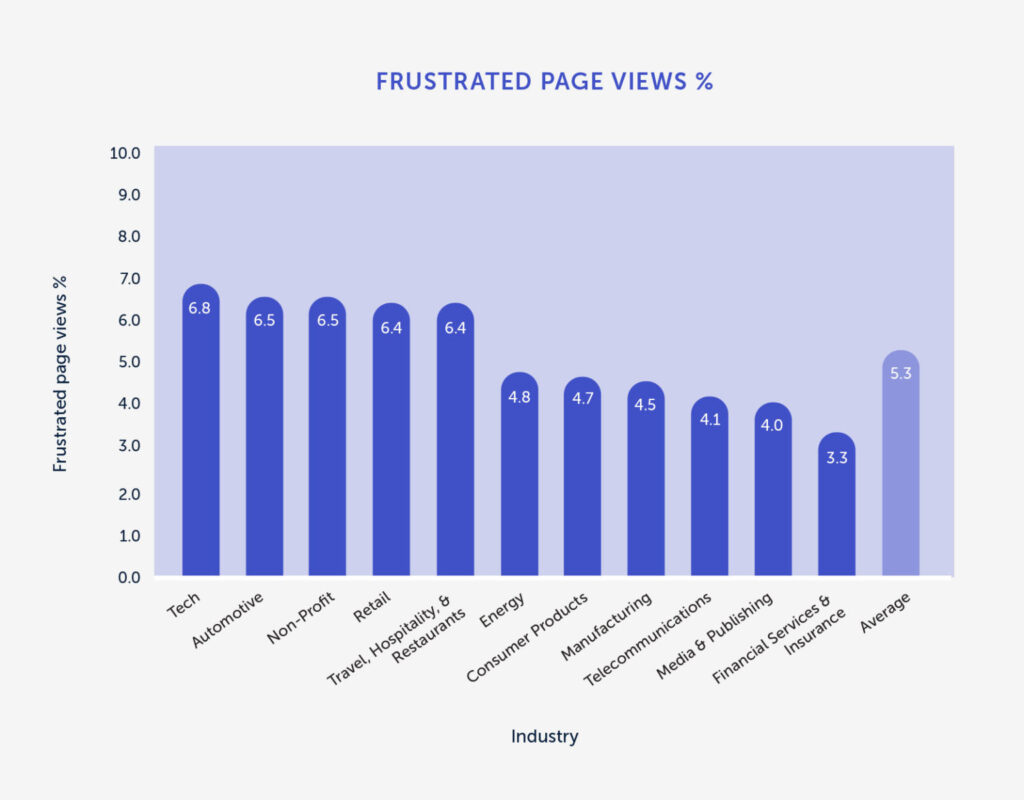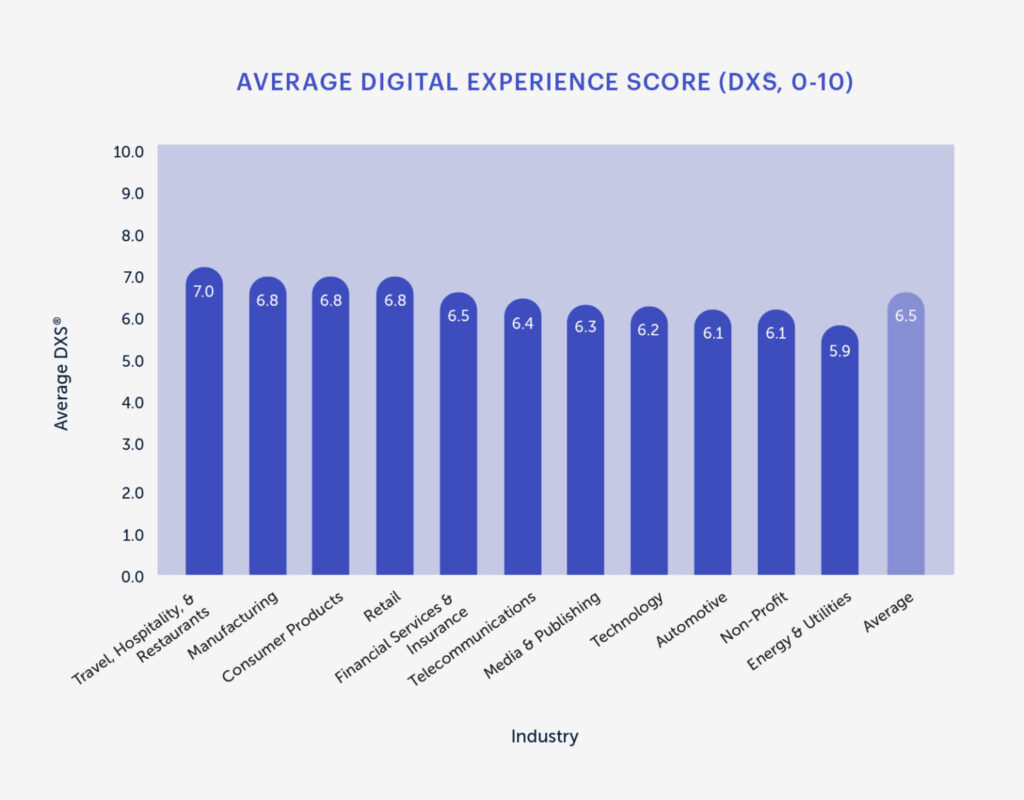Digital Experience Benchmarks: How 11 Industries Rank in the Digital Era
November 11, 2021
Digital Experience
What are your industry’s digital experience benchmarks? How do they compare to others? Discover the leaders and laggards of digital experience with our 11 industry breakdown.
In the digital era, businesses that commit to continuously improving digital experiences stand the best chance at driving consistent customer engagement, conversion, and loyalty online. In fact, when digital experience improves, it can raise a company’s KPIs up to 83% in conversion uplift. But to roll out web and app improvements that make a tangible impact on a business’ bottom line, it takes a data-driven approach to establish the current quality of digital experience and where improvements should be made.
In an effort to help businesses across industries better assess the quality of their own digital experiences, Medallia recently released its benchmarking study and report, Digital Experience & Conversion: Industry Benchmarks for 2022. The report includes benchmarking insights and trends for overall digital experience, frustration, engagement, and conversion across 11 industries. For a quick overview of this year’s benchmarking results, we’ve briefly recapped the takeaways for each industry in this blog.
How we calculated digital experience benchmarks for every industry
In order to glean actionable insights for this study, Medallia’s data scientists analyzed a sample size of over 6.5 billion user sessions throughout 2021 to identify digital experience trends and benchmarks on websites and apps. Our data scientists leveraged Medallia’s Digital Experience Score (DXS®), the first universal metric for online experience that can be measured on scale from 1–10 without any direct customer feedback needed. Accounting for digital experience pillars such as engagement, frustration, and navigation, along with form and technical experiences, DXS® helps establish reliable insights at scale — perfect for determining benchmarks.
So, how do you think your industry’s digital experiences performed this year? How does your own industry compare to others? What opportunities does your industry have to improve digital experience moving forward? Our recap rankings share those answers and more.
11 industries ranked by overall digital experience benchmarks
1. Travel, Hospitality, & Restaurants
Of the 11 industries, Travel, Hospitality, & Restaurants record the highest DXS® with an impressive 7.0/10. While it may not sound like much on the surface, Travel, Hospitality, & Retail outperforms the 6.5/10 multi-industry average by a half point, which can reflect major uplift in conversion and revenue. From hotel and flight bookings to food service, the industry generally delivers high quality digital experiences. On top of that, Travel, Hospitality, & Restaurants generate more engagement than most industries, however it causes more user frustration than average. Moving forward, brands in the industry should prioritize lower frustration through well-optimized page layouts and more seamless technical, back-end performance.
T-2. Retail
In a three-way tie for digital experience runner-up, Retail performed well this year with a 6.8/10 DXS®. Always on the cutting-edge of ecommerce digital experiences, it’s expected for the industry to rank near the top of the group. However with so much online content and a massive online customer base, it’s no surprise its user frustration sits higher than most industries. On the other hand, it drives more engagement than almost any other industry. To step it up in the digital era, Retail should prioritize continuously optimizing and personalizing its ever-changing digital content on websites and apps.
T-2. Consumer Products
Matching Retail’s 6.8/10 DXS®, Consumer Products delivers some well-received digital experiences for its online customers. With direct-to-consumer product websites, there’s usually loads of online product information and media, so it’s an impressive score for the industry. The industry also kept frustration lower than the multi-industry average, which again is surprising given the typically complex digital content. However, the industry falls short when it comes to engaging its online customers. The biggest opportunities for Consumer Products starts with improving the quality and diversity of its online content for a more engaging experience.
T-2. Manufacturing
Last but not least of the industries ranking second in overall digital experience, Manufacturing registered the same DXS® as the two industries above with a 6.8/10. An industry with a diverse range of goods for B2B and B2C, Manufacturing has prioritized digital experience well this year. A big part of its high-scoring digital experience comes from keeping user frustration on the low end. But the industry’s online engagement didn’t impress and could use some work. Next steps for Manufacturing start with a clear focus on developing digital experiences that use interactive features well and create dynamic content to pique online customer interest.

3. Financial Services & Insurance
Matching the multi-industry average with a 6.5/10 DXS®, Financial Services & Insurance certainly didn’t disappoint with digital experience, but perhaps the industry didn’t perform as well as one might expect given the rapid transformation of digital banking and insurance. Financial Services & Insurance kept user frustration the lowest out of all industries, while driving relatively average engagement — all-in-all, this is a well-rounded industry for digital experience. But to take a leap and create some of the best digital experiences around, Financial Services & Insurance should prioritize innovating and optimizing with new products and services to stay ahead of fintech disruptors.
4. Telecommunications
While Telecommunications didn’t perform poorly in overall digital experience, its 6.4/10 DXS® fell just short of the multi-industry average at 6.5/10. An industry that delivers similar-style digital experiences to Retail, it could look to that industry for inspiration to innovate and optimize. On a positive note, Telecommunications kept user frustration low compared to most industries, but it falls flat with very low engagement that just edges out the worst performer. To bring digital experiences to life for its online customers, Telecoms should put a premium focus on digital content with more engaging multimedia content, clean but eye-catching designs, and revamped web and app copy.
5. Media & Publishing
With a below-average DXS ® of 6.3/10, Media & Publishing’s digital experiences aren’t alarmingly poor, but they definitely could use some fine-tuning. In an industry where a library of online content is the main attraction that keeps users on-site, it can certainly be tricky to deliver a seamless digital experience. Despite the subpar score, the industry actually ranks quite well in terms of lower instances of frustration and higher levels of engagement, which likely means there’s more issues when it comes to navigation, along with technical and form experiences. To move the needle in Media & Publishing digital experiences, the industry should prioritize ensuring content loads properly and quickly, especially with dynamic elements such as image carousels, menus, videos, and buttons.

6. Technology
Tech produced a rather underwhelming DXS® of 6.2/10, which isn’t terrible, but it reflects plenty of opportunity for the industry to improve digital experiences heading into next year. Across Tech, brands typically offer customers a long list of products and services, which means there’s plenty of digital content to optimize. With this in mind, it’s unsurprising to see Tech’s user frustration levels among the worst performers across industries, however, the sector’s engagement levels are above average. For Tech to make new strides in digital experience, the industry must reduce user frustration with especially well-optimized technical performance to ensure on-screen content and elements function without issue.
T-7. Automotive
To some, it may not be too surprising to see Automotive rank in the bottom of the pack for overall digital experience with just a 6.1/10 DXS®. With vast amounts of highly interactive online content centered around product tours and videos along with digital showrooms, Automotive’s digital experiences are more complex than most sectors. The industry struggles to keep user frustration low with all these complex elements in its digital experiences, while its engagement is roughly around average compared to other industries. As Automotive’s digital experiences continue to mature as online car shopping normalizes, it should place a strong focus on optimizing loading times, content functionality, navigation, and forms.
T-7. Non-Profit
Often operating with fewer resources to devote to optimizing digital experience compared to other industries, Non-Profit’s 6.1/10 DXS® reflects that challenging reality. The vertical faces challenges both on the user frustration and engagement side of digital experience, as both scored well below average. Considering Non-Profit’s focus on driving engagement and conversion for donations, the sector should devote most of its resources on fine-tuning related digital experiences. Non-Profit will see the most bang for its buck by streamlining conversion-centric paths with simple page layouts, clear call-to-actions, and shorter user journeys.
8. Energy & Utilities
Rounding out the bottom of the list, Energy & Utilities is the only industry to post a sub-6.0 DXS® with a 5.9/10. While the Energy & Utilities lags behind other industries, it also has the most opportunities to transform its digital experience compared to other sectors because of this low starting point. The sector actually performed well in reducing user frustration better than several industries, but its engagement levels left much to be desired. To take digital experiences up a notch and stand out within the sector, Energy & Utilities brands can focus on streamlining navigation and user journeys, while rethinking digital content so that it’s more creative, helpful, and interesting to the online customer.












